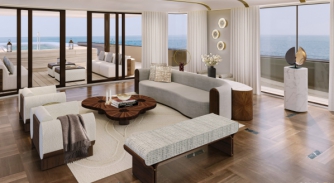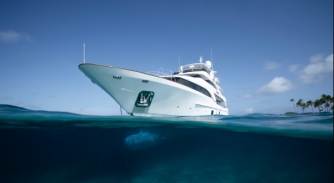Galley design: Why yacht chefs are the missing ingredient
Head chef Brennan Dates explains that the involvement of a marine catering professional is vital when designing galleys for new builds…

When a yacht owner dreams about life at sea on their new build, they will think of designer staterooms, sprawling teak decks … and world-class food that matches their global dining habits. However, they rarely think about the galley and the service areas that need to be in place to deliver on this achievable goal. This is a call to raise attention to how important these rooms are to the owner’s overall vision.
Why galleys matter
One of the most critical and often overlooked aspects of the superyacht experience are the galley and service areas. This space is the heartbeat of the yacht on a guest trip as well as the busiest on board. Food is one of the most crucial and intimate aspects of a guest trip and can single-handedly make or break it. The industry understands that the food served on board is a critical aspect to a top-performing programme – whether private or charter.
It’s a cornerstone of guest satisfaction. It keeps the busy crew up and running with meals they can look forward to as they work three weeks or more without a day off. Yet despite its importance, 80 per cent of galleys are designed without input from professional yacht chefs.
From a 10-metre Azimut to a 150-metre Lürssen, most of the galleys for owners have no chef feedback at the critical early stages of planning the general arrangement. All yacht sizes can benefit immensely from involving a yacht chef to fit the essential equipment in a space that, nine times out of ten, is too small.
Let’s talk money
On a new build, galleys cost, on average, one per cent of the entire price of the vessel. I’m not saying we need to expand the budget, I’m just trying to illustrate that with a tiny bit more advice on that one per cent, the guest experience improves significantly.
When yacht chefs are ignored in the design phase and shipyard subcontractors take over the galley and service area build-out with no real expertise, it results in workspaces that are a nightmare to operate in. No one wants to work in them, crew turnover is likely to skyrocket and the owner struggles to keep a solid team on board.
A galley designed without chef input can often require an extensive refit sooner rather than later. These retrofits can be very costly, disruptive to the owner’s schedule and very avoidable. The galley of one 80-metre new build was installed by a shipyard that subcontracted the job to a third party, with no input from a yacht chef. The result was a poorly designed workspace with inefficient workflow, inadequate food storage and domestic-grade equipment that was never meant to support 25 crew and 12 guests.
Within five years of launch, a number of chefs had resigned due to the impractical layout and home equipment, while engineers were frustrated with constant equipment failures on guest trips. Eventually, the owner was forced to spend more than $750,000 on a refit just to install the right equipment and reconfigure the layout of the space. Had a yacht chef been involved from the outset, this huge cost could have been avoided. Not only would the galley have been designed for efficiency from day one, it also would have directly improved food quality, crew performance and the guest experience – the guest experience being the overall point of the yachting industry. We need to find ways to improve this experience, not just keep the same sub-par status quo.
Even the best shipyards in the world don’t build their own galleys. Instead, they outsource the work to subcontractors – entities that, more often than not, lack the professional oversight required to create a high-functioning galley. Unless the owner’s build team includes a yacht chef, or the owner has their own yacht chef actively involved in the early planning stages, galleys are typically laid out by non-chefs who select equipment based on profit margin rather than performance. This approach leads to galleys that simply don’t work for the owner.
Professional yacht chefs bring invaluable insights into equipment type, placement, storage needs and operational flow, reducing the likelihood of an expensive post-launch refit. Involving chefs from the outset ensures the galley is built to meet the practical demands of a busy private or charter season.
Designing a superyacht galley without involving a chef is akin to building an F1 race car
without consulting an F1 driver. It’s a misstep that undermines the very essence of performance,
efficiency and luxury food service.
Enhancing efficiency and performance
Superyacht galleys are unique environments that demand seamless functionality. From serving children’s meals along with the nannies 30 minutes before an intimate family dinner for 12 to executing large-scale catering events, to being woken up throughout the night to make food for drunk guests, yacht chefs face diverse culinary challenges.
On a charter boat you have no idea what food requests guests will throw at you and it’s your job to deliver. There’s no place for home-equipment manufacturers such as Miele or Gaggenau. It might be labelled ‘professional grade’ on the front panel but every chef knows you won’t find this equipment in top restaurants or luxury hotels.
Even on a 30-metre yacht with six crew and 12 guests – 18 people to cook for three times a day – an enormous load is placed on sub-par, domestic-grade equipment more suited to a casual home kitchen than the demands of a superyacht galley. Chefs have to try to deliver on all these high-end expectations with basic equipment, sometimes alone in the galley with no sous chef and lots of mouths to feed, constantly. Why is this the norm? A galley designed with chefs’ input directly enhances efficiency, minimises wasted space and streamlines service to deliver a better guest and crew experience.
Marine-grade equipment
The marine environment presents specific challenges that land-based kitchens don’t face – from corrosion-proof materials, safety hinges on heavy oven doors to dishwasher float switches that don’t like sloshing around underway. Selecting the right equipment is crucial. Every piece of equipment needs to not only meet marine standards, but also align with chefs’ culinary needs. This dual perspective helps bridge the gap between ideas that will work in restaurants versus what will work at sea.
Let’s not forget maintenance either, such as easy access to filters, water and power connections etc., which makes it easier to properly maintain, service and fix equipment. This reduces the downtime of a galley drastically.
A logical collaboration
Designing a superyacht galley without involving a chef is akin to building an F1 race car without consulting an F1 driver. It’s a misstep that undermines the very essence of performance, efficiency and luxury food service. Professional chefs understand the nuances of their craft and bring unmatched value to the design process, and building a galley without involving a chef creates expensive problems sooner rather than later. A galley designed by an outside company that has never worked in a galley can’t compare with a foundational galley layout and equipment list specified by an ex-yacht chef.
While individual preferences may vary, professional yacht chefs consistently prioritise functionality, efficiency, and durability in a galley, with core principles such as proper workflow, adequate refrigeration and high-quality cooking equipment remaining universal. Just as all yacht captains may have slightly different preferences for bridge layouts, yet their input is never ignored, chefs should be involved in galley design through a chef consultant who ensures the space is built to work for any professional, not just for themselves.
Resolution
The galley is more than just a place where food is prepared, it’s the foundation of a trip for both guests and for the crew delivering the guest services. By involving professional yacht chefs in the design process, owners and builders can create a galley that elevates the guest experience, avoids costly refits, benefits galley crew retention and enables top-tier performance. Having a consultant involved in the build process can create a standardised design that will work for any chef, where the investment is minimal but the rewards of getting it right vastly outweigh the costs.
For those aiming to deliver the ultimate luxury experience, this collaboration is not just beneficial to the chef, it’s also essential for the smooth operation of the owner’s greatest asset.
This article first appeared in The Superyacht Report – New Build Focus. With our open-source policy, it is available to all by following this link, so read and download the latest issue and any of our previous issues in our library.
NEW: Sign up for SuperyachtNewsweek!
Get the latest weekly news, in-depth reports, intelligence, and strategic insights, delivered directly from The Superyacht Group's editors and market analysts.
Stay at the forefront of the superyacht industry with SuperyachtNewsweek
Click here to become part of The Superyacht Group community, and join us in our mission to make this industry accessible to all, and prosperous for the long-term. We are offering access to the superyacht industry’s most comprehensive and longstanding archive of business-critical information, as well as a comprehensive, real-time superyacht fleet database, for just £10 per month, because we are One Industry with One Mission. Sign up here.
Related news

Design at sea: how yacht interiors differ
Natalie Fogelström at Koja Design Studio and Anja Carlsson at Acoya Design House discuss the key differences between yacht and land-based interior design
Fleet

Ample opportunities for head chefs
Results from Quay Crew’s Superyacht Head Chef Salary Survey shed light on the benefits of having highly sought-after transferable skills in the galley
Crew

Superyacht UK Young Designer Competition commences
The event launched the 2024 Superyacht UK Young Designer competition, offering a platform for talent exploration and industry engagement
Fleet

Putting function over form
Dario Schiavo asks, can captains do more to assist shipyards, designers and owners to optimise yacht usability?
Crew

The suggestion box
Dario Schiavo explores the increasingly vital role of open and constructive dialogue between senior crew and designers in ensuring a project's success
Fleet
Related news
Design at sea: how yacht interiors differ
7 months ago
Ample opportunities for head chefs
10 months ago
Putting function over form
1 year ago
The suggestion box
1 year ago
NEW: Sign up for
SuperyachtNewsweek!
Get the latest weekly news, in-depth reports, intelligence, and strategic insights, delivered directly from The Superyacht Group's editors and market analysts.
Stay at the forefront of the superyacht industry with SuperyachtNewsweek



